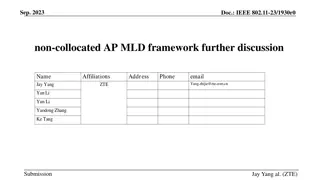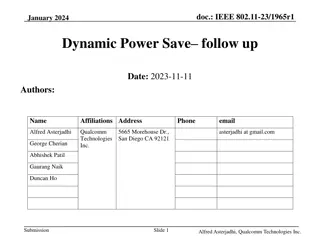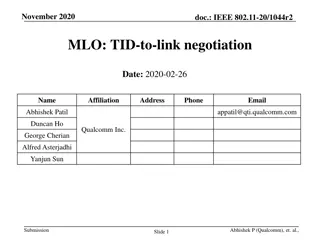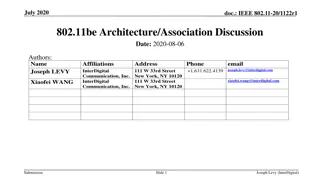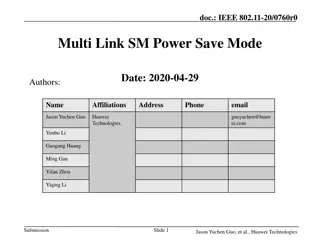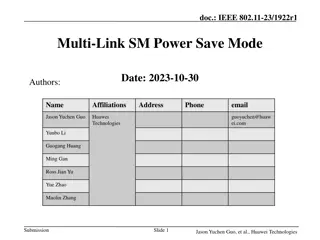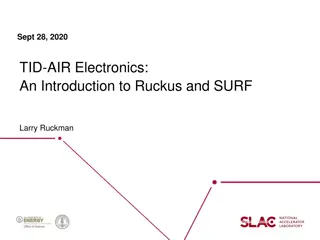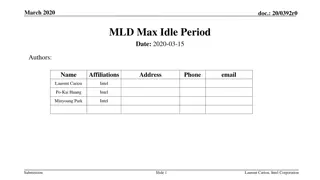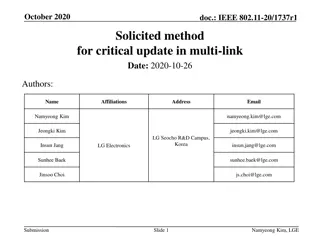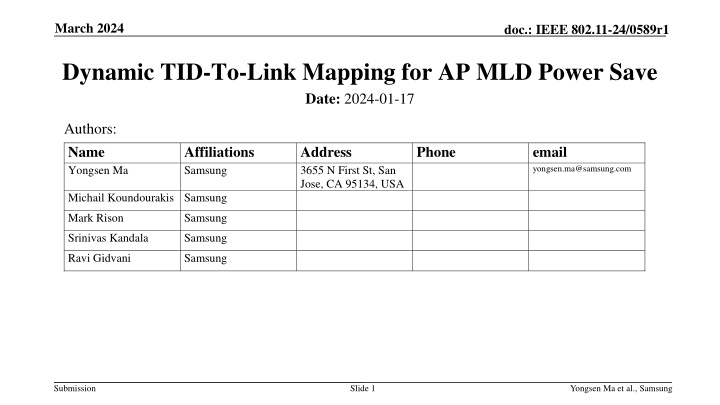
Dynamic TID-To-Link Mapping for AP MLD Power Save
Requirements and recommendations to improve energy efficiency of APs, previous contributions and proposals for power-saving protocols utilizing TWT, SMPS, MLD, EMLSR, and more. Introducing a traffic-aware power save protocol using TID-To-Link Mapping for AP MLD to enhance energy efficiency through traffic/TID load balancing, link management, and duty cycling.
Download Presentation

Please find below an Image/Link to download the presentation.
The content on the website is provided AS IS for your information and personal use only. It may not be sold, licensed, or shared on other websites without obtaining consent from the author. If you encounter any issues during the download, it is possible that the publisher has removed the file from their server.
You are allowed to download the files provided on this website for personal or commercial use, subject to the condition that they are used lawfully. All files are the property of their respective owners.
The content on the website is provided AS IS for your information and personal use only. It may not be sold, licensed, or shared on other websites without obtaining consent from the author.
E N D
Presentation Transcript
March 2024 doc.: IEEE 802.11-24/0589r1 Dynamic TID-To-Link Mapping for AP MLD Power Save Date: 2024-01-17 Authors: Name Yongsen Ma Affiliations Samsung Address 3655 N First St, San Jose, CA 95134, USA Phone email yongsen.ma@samsung.com Michail Koundourakis Samsung Mark Rison Samsung Srinivas Kandala Samsung Ravi Gidvani Samsung Submission Slide 1 Yongsen Ma et al., Samsung
March 2024 doc.: IEEE 802.11-24/0589r1 Abstract There are requirements and recommendations to improve the energy efficiency of APs [1-4]. Previous contributions and proposals [5-16] for scheduled, unscheduled and dynamic AP power save for example, utilizing TWT, SMPS, MLD, EMLSR, and limiting BW/NSS This contribution presents a traffic aware power save protocol for AP MLD utilizing TID-To-Link Mapping The AP MLD can use TID-To-Link Mapping (TTLM) for traffic/TID load balancing, link disablement/enablement, and duty cycling Can be used together with other AP power save protocols Submission Slide 2 Yongsen Ma et al., Samsung
March 2024 doc.: IEEE 802.11-24/0589r1 Related Work Existing protocols and proposals mainly focus on limiting the AP s capability in timing (TWT), frequency (BW/MLD), spatial (NSS, SMPS), power state (Active/Doze) domains [5] Limit the channel bandwidth, # antenna, NSS [7] or the 802.11 generation/version/feature BSS Termination (AP power down notification) [9] 802.11ba WUR and Wake Up AP [11, 12] RAW/S-APSD/TWT with limited SP or Listen Interval [13, 14], then the AP turns into Doze state Unscheduled AP PS and utilize MLD: certain link in active mode and other links in PS mode [6, 7, 8, 15, 16] Scheduled: TWT-based duty cycling [7, 14, 16] Dynamic: SMPS/EMLSR for APs [7], limited AP capability (BW/NSS) [15] Submission Slide 3 Yongsen Ma et al., Samsung
March 2024 doc.: IEEE 802.11-24/0589r1 Motivation Motivation: Traffic load and TID distribution can have different patterns during different time of the day in some scenarios such as home, shopping mall, office, warehouse, stadium, college campus [18] Different TID-To-Link Mapping settings can have different impact on energy efficiency for AP MLDs. We propose to use TID-To-Link Mapping for AP MLD power save The AP MLD may adjust the TTLM and Operating Mode, for example based on number of STAs, buffer status, channel load, traffic load of each TID/link on downlink and uplink. It may adapt and support different modes: load balancing, link disablement/enablement, duty cycling. TTLM may be extended to support new modes and reduced transition overhead. It could be used together with other AP power save options, e.g., adjust settings such as TWT, BW, and NSS. Submission Slide 4 Yongsen Ma et al., Samsung
March 2024 doc.: IEEE 802.11-24/0589r1 TTLM for AP MLD Power Save: Mechanism # 1 Mapping of some TID(s) to certain link(s) -> Traffic/TID load balancing between links Handled by MLD in UMAC, usually quick to switch The AP may allocate less traffic/TID on certain link(s) and reduce the BW/NSS/ for the link(s) with low traffic/channel load This mapping can be set such that high volume traffic (e.g., real-time video/gaming) on high performance link(s), and low volume traffic (e.g., background and IoT) on the link with low BW/NSS The goal is to improve the energy efficiency for AP MLDs by using lower capability, lower power/energy for lower load and using high capability when the load is high. Submission Slide 5 Yongsen Ma et al., Samsung
March 2024 doc.: IEEE 802.11-24/0589r1 TTLM for AP MLD Power Save: Mechanism # 2 Mapping of all/none TIDs to certain link(s) -> link enablement/disablement, duty cycling This operation needs hardware switching and other transitions, e.g., (dis/re)association, (re)setup; the process of switching/transitioning is usually slow For non-MLD non-AP STAs, the AP also needs to perform BSS transition/termination for (dis/re)association on the disabled link(s) (35.3.7.5.2 Affiliated AP link disablement, 11be_D5.0) The AP MLD can disable certain link(s) for certain duration and enable the link(s) later, or change the duty cycle of certain link(s) by link disablement/enablement. STAs that know the AP MLD s TTLM and link state can take actions accordingly. Submission Slide 6 Yongsen Ma et al., Samsung
March 2024 doc.: IEEE 802.11-24/0589r1 802.11be TTLM Element used for AP MLD Power Save Timing information: Mapping Switch Time and Expected Duration provide timing and scheduling information Support mostly static operations and not easy to support periodic/predictable/dynamic TTLM patterns Disadvantages of link disablement/enablement: High transition overhead/delay, long turn-around time. Need BSS termination/transition for non-MLD non-AP STAs for disabled link(s) to do (dis/re)association Unassociated non-AP STAs shall not transmit multi-link probe request, Authentication, and (Re)association Request frames on disabled link(s) Takes time and introduces overhead for TTLM maintenance/update, ML (re)setup, etc. Submission Slide 7 Yongsen Ma et al., Samsung
March 2024 doc.: IEEE 802.11-24/0589r1 Potential Changes to Extend the TTLM Element (1/2) To support periodic/predictable/dynamic patterns: Add subfields, such as interval, persistence, and count information The AP may adjust the TTLM dynamically, and non-AP STAs may know the TTLM pattern and the AP s link/power state in advance and take actions accordingly, e.g., PS mode, Probe Request, ML (re)setup. Submission Slide 8 Yongsen Ma et al., Samsung
March 2024 doc.: IEEE 802.11-24/0589r1 Potential Changes to Extend the TTLM Element (2/2) To reduce transition overhead: Add subfields for simplified BSS/MLD operations for link disablement/enablement Add a mode for a link being partially disabled for user data (no TID mapped to the link), while keeping up to support management operations, and have options for non-AP MLDs and AP MLDs to negotiate/indicate such mode on certain link(s). The AP may switch between Active state and Doze state quickly on certain link(s), which helps reduce transition overhead in terms of BSS transition/termination, (dis/re)association, ML (re)setup, etc. Submission Slide 9 Yongsen Ma et al., Samsung
March 2024 doc.: IEEE 802.11-24/0589r1 TTLM for AP MLD Power Save: Options (1/2) AP and non-AP STA operations The AP MLD and non-AP MLD negotiate a new TTLM to support switching of the links. Through the new TTLM, the AP could do the following on certain link(s): Keeps the link(s) enabled, and may operate in reduced capability and with less TID(s) mapped Keeps the link(s) disabled, and performs BSS transition/termination for non-MLD non-AP STAs Keeps the link(s) disabled for user data, but enabled for management type operations, and continues to transmit Beacons and respond to Probe Request To support non-AP MLDs/STAs that do not operate on all bands (including to support coexistence), non-AP MLDs may select certain link(s) for transmissions/receptions. AP MLD may determine to continue or stop Beaconing based on the non-AP MLDs/STAs selection. Submission Slide 10 Yongsen Ma et al., Samsung
March 2024 doc.: IEEE 802.11-24/0589r1 TTLM for AP MLD Power Save: Options (2/2) Can be used together with other AP power save protocols/options in slide 3 For example, the AP may gradually shift the traffic/TID load from one link to another link, and the link with reducing traffic/TID load can reduce the BW/NSS or turn to Doze state. Multi-AP coordination for traffic/TID load balancing and spatial/time/frequency/ resource allocation Submission Slide 11 Yongsen Ma et al., Samsung
March 2024 doc.: IEEE 802.11-24/0589r1 TTLM for AP MLD Power Save: Examples The AP MLD may adjust the TTLM and Operating Mode based on pre-determined scheduling (e.g., office, shopping mall, stadium), dynamic adjustment (e.g., smart AP that can measure and predict traffic/channel load), and other conditions. AP1 (link1) is always operating in full capability with all TIDs mapped for this example, but it may also operate in other modes. AP2 (link2) may operate in Full capability Reduced capability All TIDs mapped Certain TID(s) mapped No TID mapped, link disabled for user data but enabled for management operations No TID mapped, link disabled Submission Slide 12 Yongsen Ma et al., Samsung
March 2024 doc.: IEEE 802.11-24/0589r1 TTLM for AP MLD Power Save: Example 1 Load balancing with reduced capability and link disablement/enablement based on traffic/link load Submission Slide 13 Yongsen Ma et al., Samsung
March 2024 doc.: IEEE 802.11-24/0589r1 TTLM for AP MLD Power Save: Example 2 Link1 disabled for MLD user data, management operations still on Submission Slide 14 Yongsen Ma et al., Samsung
March 2024 doc.: IEEE 802.11-24/0589r1 TTLM for AP MLD Power Save: Example 3 Duty cycling by link disablement/enablement Submission Slide 15 Yongsen Ma et al., Samsung
March 2024 doc.: IEEE 802.11-24/0589r1 TTLM for AP MLD Power Save: Example 4 Duty cycling by traffic/TID load balancing and reduced capability Submission Slide 16 Yongsen Ma et al., Samsung
March 2024 doc.: IEEE 802.11-24/0589r1 Conclusion This contribution presents a power save protocol for AP MLDs utilizing TID-To-Link Mapping Reuse TTLM for traffic load balancing, link disablement/enablement, and duty cycling to improve energy efficiency of AP MLDs Potentially to extend the TTLM element to support periodic/predictable/dynamic TTLM patterns and to reduce transition overhead Extend signalling between non-AP MLD and AP MLD to allow disabled links (no TID mapped for DL and UL) to be used for Beacon and other critical management operations (connection keep alive, Probe Request/Response, etc.) Submission Slide 17 Yongsen Ma et al., Samsung
March 2024 doc.: IEEE 802.11-24/0589r1 References [1] Dorothy Stanley, Liaison statement from Wi-Fi Alliance re: energy efficiency, IEEE 802.11-23/0917r0, 2023 [2] Amelia Andersdotter, et al., 802.11 AP Power Save PAR addition proposal, IEEE 802.11-23/0244r1, 2023 [3] Amelia Andersdotter, et al., Green AP and resilience requirements for home networks, IEEE 802.11-22/1790r0, 2022 [4] Lili Hervieu, et al., A Perspective on UHR Features for Operator Residential Deployments, IEEE 802.11-22/1809r0, 2022 [5] Yongsen Ma, et al., AP Power Management, IEEE 802.11-23/1835r0, 2023 [6] Liwen Chu, et al., AP MLD power management, IEEE 802.11-23/0015r0, 2023 [7] Alfred Asterjadhi, et al., Considerations for enabling AP power save, IEEE 802.11-23/0010r0, 2023 [8] Guogang Huang, et al., Considering Unscheduled AP Power Save, IEEE 802.11-23/0225r0, 2023 [9] Stefan Aust, AP Power Saving, IEEE 802.11-11/0046r2, 2011 [10] Stefan Aust, TGah Use Case AP Power Saving in Smart Grid, IEEE 802.11-11/0273r0, 2011 [11] Xiaofei Wang, et al., AP Power Saving, IEEE 802.11-17/0728r2, 2017 [12] Xiaofei Wang, et al., On AP Power Saving Usage Model, IEEE 802.11-17/1388r2, 2017 [13] Jay Yang, et al., MLD AP Power-saving(PS) Considerations, IEEE 802.11-20/1115r6, 2020 [14] Kyumin Kang, et al., Considerations on Soft AP Power Saving, IEEE 802.11-21/0885r1, 2021 [15] George Cherian , et al., Enabling AP power save_follow up, IEEE 802.11-23/2040r1, 2023 [16] Liwen Chu, et al., AP MLD power save follow up, IEEE 802.11-23/1936, 2023 [17] Yongsen Ma, et al., AP Power Management Follow-up, IEEE 802.11-24/0097, 2024 [18] Stefan Tschimben, Modeling and Generation of Realistic Network Activity, IEEE 802.11-24/0548, 2024 Submission Slide 18 Yongsen Ma et al., Samsung

